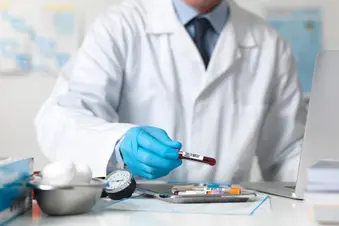
When you have exocrine pancreatic insufficiency (EPI), you probably know your body doesn’t feel right. Still, it’s not always easy for doctors to diagnose your condition.
The classic symptoms of EPI -- weight loss, greasy and foul-smelling stools that float or are tough to flush, stomach cramps, and diarrhea -- mimic the telltale signs of many other digestive diseases. You might even have one of those diseases along with EPI, like Crohn’s or celiac disease. That makes it hard for doctors to know exactly which condition is causing you trouble. To add to the confusion, not everyone with EPI has the same classic symptoms. Other warning signs can be too subtle for you to notice.
To figure out what’s going on, your doctor will use tests to see how many nutrients your body is absorbing from food. Here’s a rundown of the tests they might use.
Blood work. Your doctor will take a sample of your blood and send it to a lab to check it for anemia, a condition in which your body doesn’t have enough healthy red blood cells. The lab will also test your blood for vitamin B12, iron, and folate. If the levels are too low, that can mean EPI is keeping your body from absorbing these nutrients.
The lab might also look for a chemical your pancreas makes to help with digestion called trypsinogen. A level that’s too high is a sign of a problem.
Fecal elastase test. You’ll give your doctor a solid stool sample. The lab will check it for an enzyme your pancreas makes to help your body digest protein, called elastase. If you have EPI, the amount might be less concentrated than normal.
3-day fecal test. You’ll need to collect samples of your stool in special containers for about 3 days and give them to your doctor. The lab will test them for the amount of fat they have.
CT scan. This machine looks like a giant doughnut. It takes special X-rays that show your tissues and blood vessels, along with your bones. You’ll lie on a padded table that slides you up so the machine is over your upper tummy. The doctor may take one set of images and then ask you to drink a kind of dye (they’ll call it contrast) to get a better picture of the area. Tell your doctor if you’ve had a bad reaction to the dye in the past or if you’re allergic to shellfish, like shrimp, crab, lobster, oysters, scallops, clams, or mussels. A basic scan takes about 10-15 minutes, but if you need contrast, you’ll be there longer.
Endoscopic ultrasound. Your doctor might need to take a closer look at your pancreas and other organs to see if they’re damaged or inflamed. In a hospital, doctors will put a thin tube in your mouth, down through your stomach, and into the first part of your small intestine. At the tip is an ultrasound probe that gives off sound waves. They help make a picture of the inside of your body, which doctors can see on a screen.
You might be asleep or awake for the test, but you’ll get medicine to make you more comfortable. The test usually takes 20 to 45 minutes, and you won’t need to stay in the hospital overnight. During this test, your doctor can also take a small piece of your tissue to study under a microscope -- if they need one.
MRI and MRCP. The MRI machine uses a magnet to take detailed pictures of your insides. You’ll lie on a padded table, and it will slide until your upper belly is under the magnet. You’ll be awake for it, but if you get anxious in small, tight spaces, the doctor might give you a drug to help you relax. You won’t have to stay overnight in the hospital. An MRCP is a special kind of MRI that focuses on your bile ducts and ducts in your pancreas. The MRI takes about 35 minutes. The MRCP takes about 10 minutes.
Show Sources
SOURCES:
Cleveland Clinic: “Disease and Conditions, Fecal elastase test.”
Dominguez-Munoz, J. Gastroenterology & Hepatology, June 2011.
The National Pancreas Foundation: “Exocrine Pancreatic Insufficiency,” “Pancreas Endoscopic Ultrasound (EUS).”
The National Pancreas Foundation: “Pancreas Endoscopic Ultrasound (EUS).”
Medscape: “Exocrine Pancreatic Insufficiency Clinical Presentation,” “Exocrine Pancreatic Insufficiency: Seen but Not Recognized?”
University of Rochester Medical Center: “Trypsinogen (blood).”
RadiologyInfo.org: “Magnetic Resonance Cholangiography/Pancreatography (MRCP).”
The Pancreas Center: “Non-Invasive Tests.”
FARE: “Shellfish.”
St. Michael’s: “Medical Imagine: CT (CAT) Scan.”